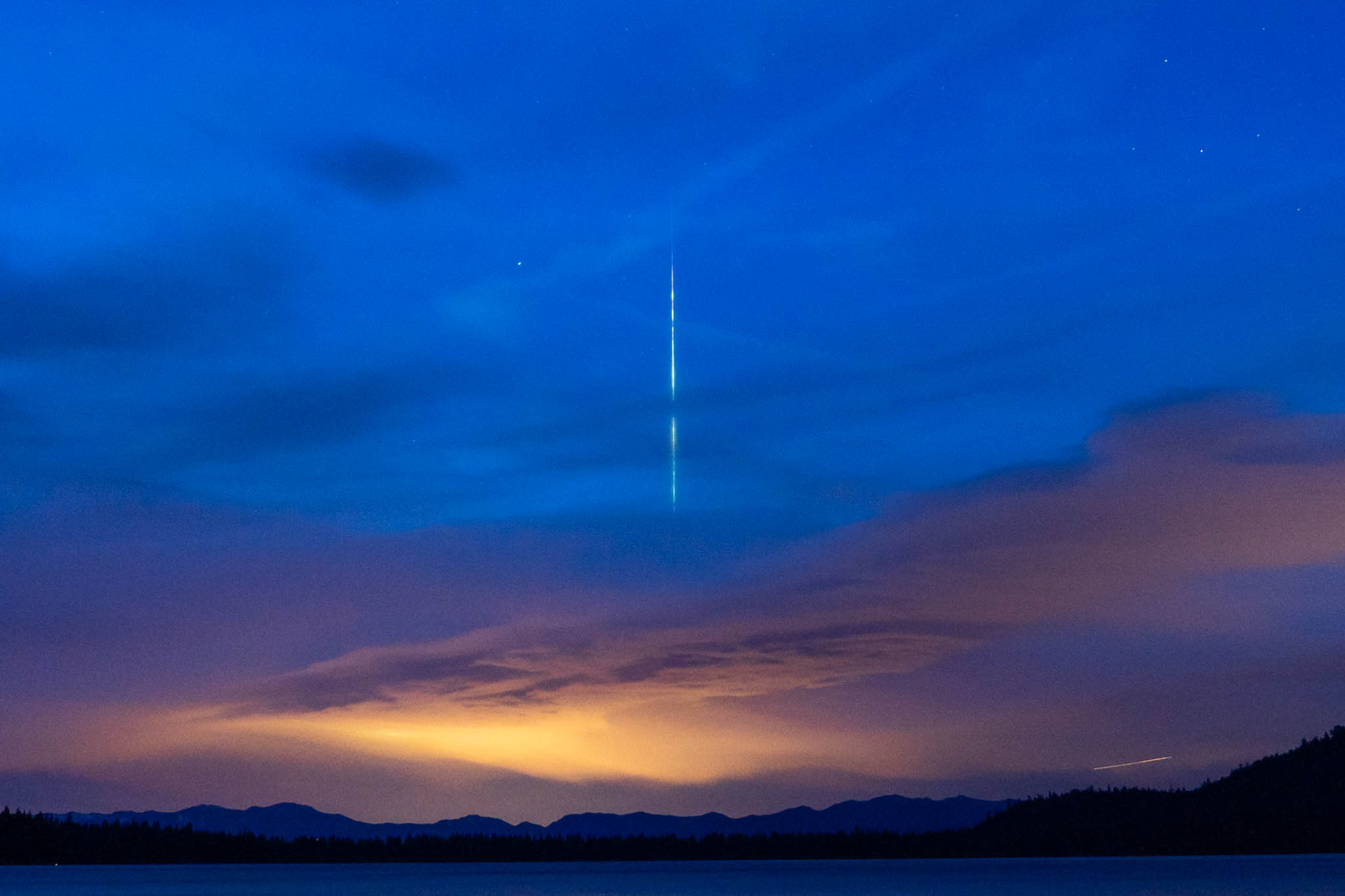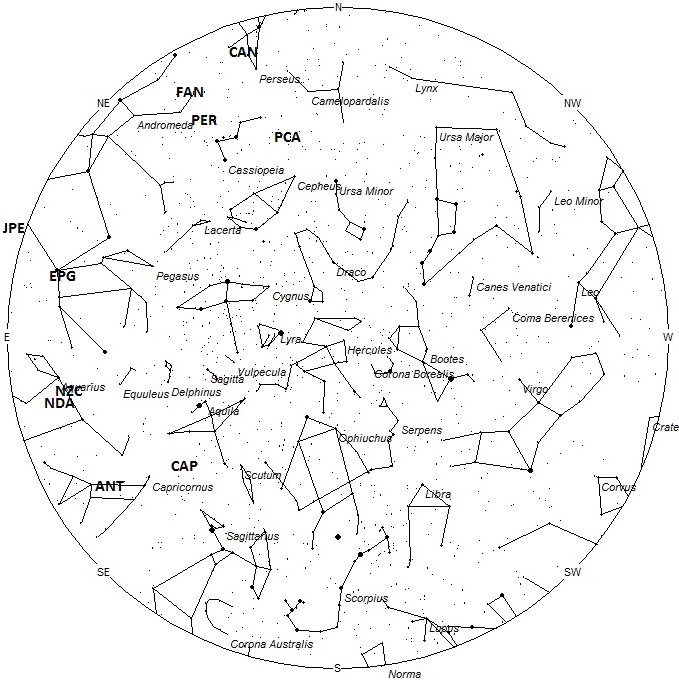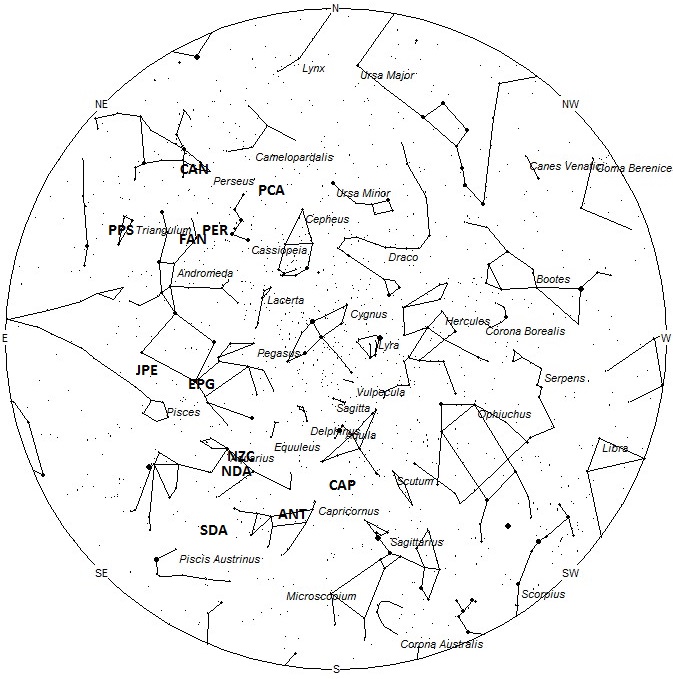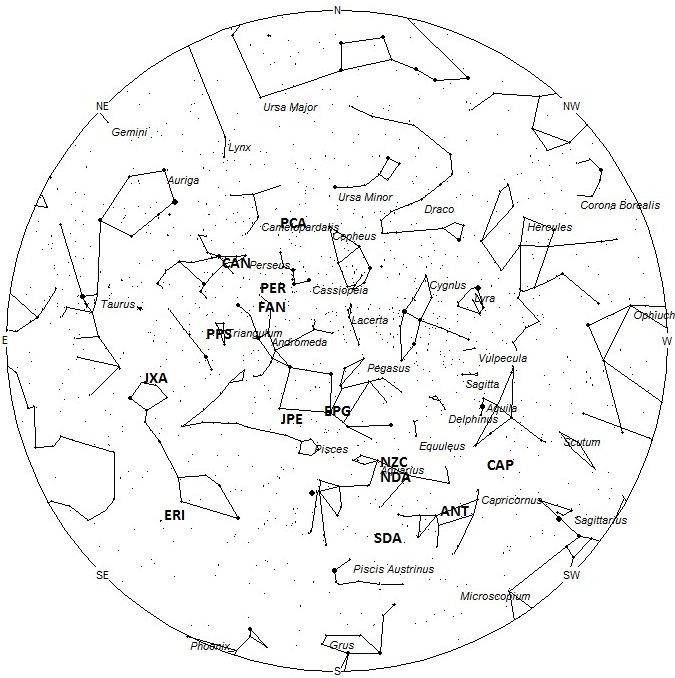 Carl Rosendahl captured this fireball through high clouds at 04:26 Universal Time on June 28, 2019 from South Lake Tahoe CA. USA © Carl Rosendahl
Carl Rosendahl captured this fireball through high clouds at 04:26 Universal Time on June 28, 2019 from South Lake Tahoe CA. USA © Carl RosendahlDuring this period the moon reaches its last quarter phase on Wednesday July 24th. On that date the moon is located 90 degrees west of the sun and rises near 0100 local daylight saving time (LDST). This weekend the waning gibbous moon will rise during the late evening hours and will interfere with viewing meteor activity during the more active morning hours. In fact the moon will be a nuisance during this entire period. One can either view during the slow evening hours prior to moonrise or view during the more active morning hours, keeping the moon well out of your field of view. The estimated total hourly meteor rates for evening observers this week is near 4 no matter your location. For morning observers the estimated total hourly rates should be near 17 as seen from mid-northern latitudes (45N) and 14 as seen from tropical southern locations (25S). The actual rates will also depend on factors such as personal light and motion perception, local weather conditions, alertness and experience in watching meteor activity. Morning rates are reduced during this period due to moonlight. Note that the hourly rates listed below are estimates as viewed from dark sky sites away from urban light sources. Observers viewing from urban areas will see less activity as only the brightest meteors will be visible from such locations.
The radiant (the area of the sky where meteors appear to shoot from) positions and rates listed below are exact for Saturday night/Sunday morning July 20/21. These positions do not change greatly day to day so the listed coordinates may be used during this entire period. Most star atlases (available at science stores and planetariums) will provide maps with grid lines of the celestial coordinates so that you may find out exactly where these positions are located in the sky. A planisphere or computer planetarium program is also useful in showing the sky at any time of night on any date of the year. Activity from each radiant is best seen when it is positioned highest in the sky, either due north or south along the meridian, depending on your latitude. It must be remembered that meteor activity is rarely seen at the radiant position. Rather they shoot outwards from the radiant so it is best to center your field of view so that the radiant lies at the edge and not the center. Viewing there will allow you to easily trace the path of each meteor back to the radiant (if it is a shower member) or in another direction if it is a sporadic. Meteor activity is not seen from radiants that are located below the horizon. The positions below are listed in a west to east manner in order of right ascension (celestial longitude). The positions listed first are located further west therefore are accessible earlier in the night while those listed further down the list rise later in the night.
These sources of meteoric activity are expected to be active this week.
The July gamma Draconids (GDR) were first noticed by Japanese observers using SonotoCo and the IMO’s network team of Sirko Molau and Juergen Rendtel in 2009. This stream is active from July 22-30 with maximum activity occurring on July 28. The radiant is currently located at 18:28 (277) +50, which places it in southeastern Draco, 4 degrees southeast of the 2nd magnitude star known as Eltanin (gamma Draconis). The radiant also lies 12 degrees due north of the brilliant zero magnitude star Vega (alpha Lyrae). This radiant is best placed near 23:00 local standard time (LDST), when it lies on the meridian and is located highest in the sky. With an entry velocity of 28 km/sec., the average gamma Draconid meteor would be of medium-slow velocity. In 2016, this stream produced a strong outburst that lasted approximately 1 hour. If a repeat performance occurs this year it will most likely occur near 18:00 Universal Time on July 28. Nothing unusual occurred in 2017 and 2018. Some researchers feel these meteors are related to the kappa Cygnids, which are active next month.
The alpha Capricornids (CAP) are active from July 3 through August 11 with maximum activity occurring during the last week of July. The broad maximum occurs anywhere from July 25 to the 30th with visual rates usually around 3 per hour. The radiant is currently located at 19:43 (296) -12, which places it in northeastern Sagittarius, 7 degrees west of the naked eye double star known Algedi (alpha Capricorni). This radiant is best placed near midnight (LDST), when it lies on the meridian and is located highest in the sky. Hourly rates at this time should be near 1 no matter your location. With an entry velocity of 22 km/sec., the average alpha Cap meteor would be of slow velocity.
The center of the large Anthelion (ANT) radiant is currently located at 20:44 (311) -21. This position lies in central Capricornus, 4 degrees west of the 4th magnitude star known as Dorsum (theta Capricorni). Due to the large size of this radiant, anthelion activity may also appear from western Aquarius and eastern Sagittarius as well as Capricornus. This radiant is best placed near 0100 (LDST), when it lies on the meridian and is located highest in the sky. Rates at this time should be near 2 per hour as seen from the southern tropics (S 25) and 1 per hour as seen from mid-northern latitudes (45 N). With an entry velocity of 30 km/sec., the average anthelion meteor would be of slow velocity.
The last of the Northern June Aquilids (NZC) are predicted to be seen this weekend from a radiant located at 21:47 (327) -01. This area of the sky is located in northern Aquarius, 4 degrees west of the 3rd magnitude star known as Sadalmelik (alpha Aquarii). This radiant is best placed near 0200 LDST, when it lies on the meridian and is located highest in the sky. Hourly rates at this time should be less than 1 no matter your location. With an entry velocity of 38 km/sec., the average meteor from this source would be of medium-slow velocity. An interesting fact about this source is that it may be related to the Northern delta Aquariids of August. Where and when this source ends coincides closely with the start and position of the Northern delta Aquariids.
The Northern delta Aquariids (NDA) are active from July 23 through August 27. The radiant is currently located at 21:46 (326) -07. This position is located in western Aquarius, 3 degrees east of the 3rd magnitude star known as Sadalsuud (beta Aquarii). Maximum activity is not expected until August 14, so hourly rates will low at this time. The radiant is best placed near 0200 LDST, when it lies highest in the sky. With an entry velocity of 38 km/sec., these meteors would be of medium velocities. This shower seems to be a continuation of the Northern June Aquilids, which has been active since early June.
The Southern Delta Aquariids (SDA) are now active from a radiant located at 22:06 (332) -20. This position is located in southwestern Aquarius, 10 degrees southwest of the 3rd magnitude star known as Skat (delta Aquarii). Maximum activity is expected on July 30th. Current hourly rates will depend on your latitude. Those viewing from the southern tropics will see the best rates of near 2-3 per hour. Rates seen from mid-northern latitudes will range from 1-2 per hour, depending on the haziness of your skies. The radiant rises near 21:00 LDST for observers located in the southern tropics, but is best placed near 0200 LST, when it lies highest in the sky. With an entry velocity of 41 km/sec., most activity from this radiant would be of average velocities.
The last of the epsilon Pegasids (EPG) are expected this weekend from a radiant located at 22:36 (339) +17. This area of the sky lies in western Pegasus, 4 degrees west of the 2nd magnitude star known as Markab (alpha Pegasi). These meteors are best seen near 0300 LDST when the radiant lies highest in the sky. Hourly rates are expected to be less than 1 no matter your location. With an entry velocity of 28 kilometers per second, a majority of these meteors will appear to move with medium-slow velocities.
The July Pegasids (JPE) have been noticed for some time now but have had a checkered history. It has been added, dropped, and then re-added to several radiant lists. Video studies within the past 10 years have positively identified this source as an active radiant during the entire month of July. Maximum activity occurs on July 10th. The radiant is currently located at 23:48 (357) +14. This area of the sky is located in southern Pegasus, 4 degrees southwest of the 3rd magnitude star known as Algenib (gamma Pegasi). This radiant is best placed near 0400 LDST, when it lies on the meridian and is located highest in the sky. Rates are expected to be near 1 per hour this week no matter your location. With an entry velocity of 68 km/sec., the average meteor from this source would be of swift velocity.
The Perseids (PER) are active from a radiant located at 01:00 (015) +52. This position is not is Perseus, rather it lies in southern Cassiopeia, 5 degrees southeast of the 2nd magnitude star known as Schedar (alpha Cassiopeiae). This area of the sky is best placed for viewing during the last dark hour before dawn when it lies highest in the sky. Maximum is not until August 13 so current rates are expected to be near 2 per hour as seen from the northern hemisphere and 1 as seen from south of the equator. Unfortunately these meteors are not well seen from the southern hemisphere. With an entry velocity of 59 km/sec., the average meteor from this source would be of swift velocity.
The 49 Andromedids (FAN) were discovered by Željko Andreić and the Croatian Meteor Network team based on studying SonotaCo and CMN observations (SonotaCo 2007-2011, CMN 2007-2010). These meteors are active from July 6 through August 14 with maximum activity occurring on July 21. The current position of the radiant is 01:41 (025) +48. This position lies in northeastern Andromeda, only 1 degree south of the 4th magnitude star known as 51 Andromedae.. Rates are currently expected to be near 1 per hour as seen from the northern hemisphere and less than 1 as seen from the southern hemisphere. With an entry velocity of 60 km/sec., the average meteor from this source would be of swift speed.
The eta Eridanids (ERI) were discovered by Japanese observers back in 2001. Activity from this stream is seen from July 23 through September 17 with maximum activity occurring on August 11. The radiant currently lies at 01:44 (026) -19, which places it in southern Cetus, 3 degrees south of the 4th magnitude star known as tau Ceti. This area of the sky is best seen during the last dark hour before dawn when the radiant lies highest in a dark sky. Current rates are expected to be less than 1 per hour during this period no matter your location. With an entry velocity of 65 km/sec., the average meteor from this source would be of swift velocity.
The phi Piscids (PPS) were discovered by Dr. Peter Brown and associates using data from the Canadian Meteor Orbit Radar (CMOR) installation. These meteors are active from June 8-August 02 with maximum activity occurring on July 5th. The radiant position currently lies at 02:10 (032) +31. This area of the sky lies in Triangulum, 2 degrees northeast of the 3rd magnitude star known as (alpha Trianguili). These meteors are best seen near during the last dark hour of the night when the radiant lies highest in a dark sky. Current hourly rates should be near 1 per hour as seen from the northern hemisphere and less than 1 as seen from south of the equator. With an entry velocity of 67 kilometers per second, a majority of these meteors will appear to move with swift velocities.
The psi Cassiopeiids (PCA) were discovered by Zdenek Sekanina in his study of radio streams. These meteors are active from July 5 through August 7 with maximum activity occurring on July 22. The current position of the radiant is 02:13 (033) +73. This position lies in northern Cassiopeia, just southeast of the faint star known as 50 Cassiopeiae. Hourly rates are currently expected to be near 1 per hour as seen from the northern hemisphere and less than 1 as seen from south of the equator. With an entry velocity of 42 km/sec., the average psi Cassiopeiid meteor would be of medium speed.
The c-Andromedids (CAN) were discovered by Sirko Molau and Juergen Rendtel using video data from the IMO network. Activity from this source is seen from June 26 through July 27 with maximum activity occurring on July 9. The radiant currently lies at 02:49 (042) +52, which places it in northwestern Perseus, 1 degrees south of the 4th magnitude star known as tau Persei. This area of the sky is best seen during the last dark hour before dawn when the radiant lies highest in a dark sky. Observers in the northern hemisphere are better situated to view this activity as the radiant rises much higher in the sky before dawn compared to southern latitudes. Current rates would be less than 1 per hour for southern hemisphere observers and near 1 for observers in the northern hemisphere. With an entry velocity of 58 km/sec., the average meteor from this source would be of swift velocity.
The July chi Arietids (JXA) were discovered by two investigating teams in Europe using video data from European video Meteor Network Database (EDMOND), SonotaCo, 2013; and CMN, 2013. Activity from this stream is seen from July 2 through August 1 with maximum activity occurring on July 13. The radiant currently lies at 02:53 (043) +11, which places it in southern Aries, 2 degrees northeast of the 4th magnitude star known as mu Ceti. This area of the sky is best seen during the last dark hour before dawn when the radiant lies highest in a dark sky. Current rates are expected to be near 1 per hour during this period, no matter your location. With an entry velocity of 69 km/sec., the average meteor from this source would be of swift velocity.
Morning rates for sporadic meteors would be near 5 per hour no matter your location. Evening rates would be near 3 per hour. Morning rates are reduced during this period due to moonlight.
The list below offers the information from above in tabular form. Rates and positions are exact for Saturday night/Sunday morning except where noted in the shower descriptions.
| SHOWER | DATE OF MAXIMUM ACTIVITY | CELESTIAL POSITION | ENTRY VELOCITY | CULMINATION | HOURLY RATE | CLASS |
| RA (RA in Deg.) DEC | Km/Sec | Local Daylight Saving Time | North-South | |||
| gamma Draconids (GDR) | Jul 28 | 18:28 (277) +50 | 28 | 00:00 | <1 – <1 | II |
| alpha Capricornids (CAP) | Jul 27 | 19:43 (296) -12 | 22 | 01:00 | 1 – 1 | II |
| Anthelion (ANT) | – | 20:44 (311) -21 | 30 | 02:00 | 1 – 2 | II |
| Northern delta Aquariids (NDA) | Aug 14 | 21:46 (326) -07 | 38 | 03:00 | <1 – <1 | IV |
| Northern June Aquilids (NZC) | Jul 03 | 21:47 (327) -01 | 38 | 03:00 | <1 – <1 | IV |
| Southern Delta Aquariids (SDA) | Jul 30 | 22:06 (332) -20 | 41 | 03:00 | 2 – 3 | I |
| epsilon Pegasids (EPG) | Jul 11 | 22:36 (339) +17 | 28 | 04:00 | <1 – <1 | IV |
| July Pegasids (JPE) | Jul 10 | 23:48 (357) +14 | 68 | 05:00 | 1 – 1 | IV |
| Perseids (PER) | Aug 13 | 01:00 (015) +52 | 59 | 06:00 | 2 – 1 | I |
| 49 Andromedids (FAN) | Jul 21 | 01:41 (025) +48 | 60 | 07:00 | 1 – <1 | IV |
| eta Eridanids (ERI) | Aug 11 | 01:44 (026) -19 | 67 | 07:00 | 2 – 1 | IV |
| phi Piscids (PPS) | Jul 05 | 02:10 (032) +31 | 67 | 07:00 | 1 – <1 | IV |
| psi Cassiopeiids (PCA) | Jul 22 | 02:13 (033) +73 | 42 | 07:00 | 1 – <1 | IV |
| c-Andromedids (CAN) | Jul 09 | 02:49 (042) +52 | 58 | 08:00 | 1 – <1 | IV |
| July chi Arietids (JXA) | Jul 13 | 02:53 (043) +11 | 69 | 08:00 | 1 – 1 | IV |
 American Meteor Society
American Meteor Society



Today Sunday 21 July at 00.30 South African time, I was outdoors by chance and I saw something I’d never seen ’til then – a massive stripe of vivid bright green like a long brush-stroke, heading straight downwards. Down at the broader end was a red-orange blob. It was visible for perhaps a second. This is the Cape Peninsula so one sees marine flares on and off, but they linger and they are nowhere near the scale and the evident height. It was many times the size of a flare. I assumed that it was a very unusual meteor. I’ve never seen one so massive and thus so seemingly ‘close’. I assume that the colours are to do with mineral elements? Or maybe simply some kind of refraction of light in the night sky? By rule of thumb I’d say it was south-east in the sky – over the Southern Ocean – if such locating of a meteorite makes sense. (Cape Town, South Africa).
I’ve just seen something very very similar to what you’re describing, Peter! It was around 23:05 Eastern Time when a bright and vibrant green meteor flew West across the sky over Cape Cod in Harwich, Massachusetts. Never seen or heard of a green meteor before so very cool that two of them have happened so close together, maybe Earth’s been moving through a batch of them the last couple of days!
11:04 pm, 07/24/19 Putnam, CT—was blessed to see this same green fireball streak across the sky heading east to west.
My question is: where was it located over? New Jersey? It seemed so close
I saw a meteor (looked way too big to be a shooting star) at 1143 pm in Wisconsin. It last for about 5 seconds.
My son and I saw a big meteor around 9pm in Roseburg, Oregon. I’ve never seen one so close!
Just saw one at around 1110pm eastern on 7/24/19 over south jersey coming over the bridge from Philadelphia
Greenish blue fireball seen at my house (north of Allentown, PA USA) around midnight (? didn’t think to look at time tbh) over the southeastern sky. Only lasted a second but it was magical. Blessed to have been in the right place at the right time and looking in the right direction when the heavens chose to let this one light up my night sky. Did anyone else see what I saw? Any confirmed reports of this event? Thank you universe for that wonderous gift.